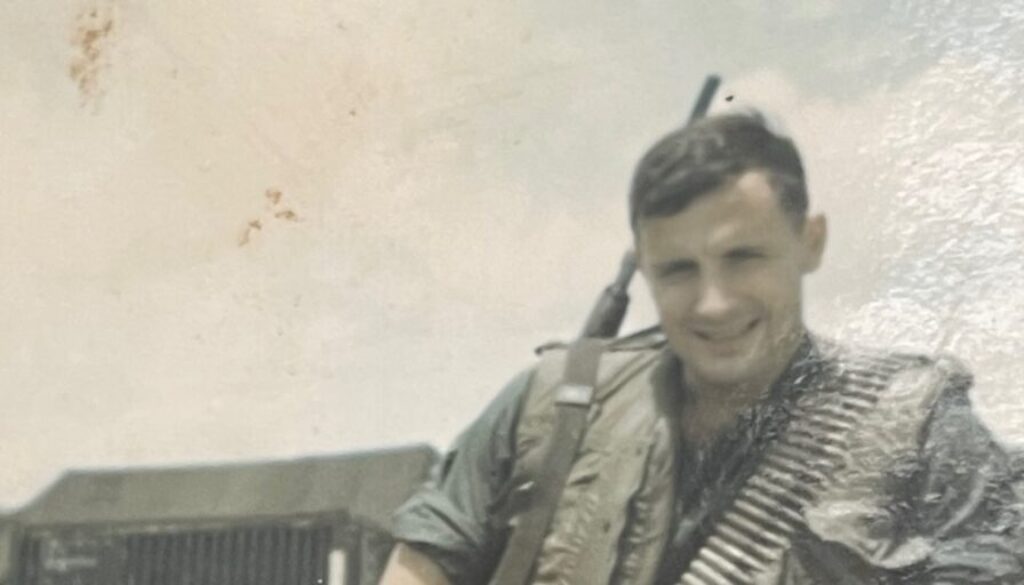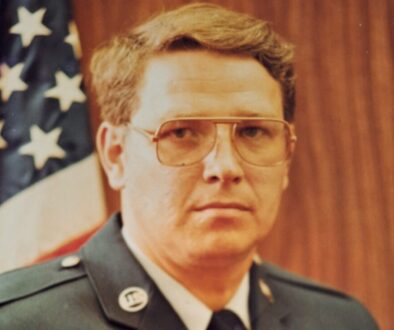Specialist 4 Thomas Steffl, U.S. Army – Drafted for Service in Vietnam
By definition, the draft is disruptive. It yanks people out of their communities and commits them to military service, usually during time of war. Such was the case for Specialist 4 Thomas Steffl, who was drafted for service in the U.S. Army after graduating from college in 1965. His commitment took him to Vietnam, where he maintained communication wires and defended base camps during 1966 and 1967. He then returned to the United States and got his life back on track, working hard to earn a slice of the American dream for his family. This is his story.
Tom was born in 1943 and grew up in and around Echo, Minnesota, located about 125 miles west of Minneapolis. His parents were poor and his dad struggled to keep things together, so they moved around at first until they started sharecropping on land owned by Tom’s uncle. Life was basic, as their farmhouse didn’t have indoor plumbing or even running water until Tom’s sophomore year of high school. Given Tom’s father’s struggles, Tom and his brother played an oversized role in keeping their farm afloat.
When Tom wasn’t working on the farm, he attended school. He transferred to Echo High School during his freshman year, where he played football and basketball and ran track, but his favorite sport was basketball. Although the school was tiny and the basketball playoffs at the end of the season were not divided by the size of the school, Echo High School put together a strong team which made a run deep into the state tournament. The experience added excitement to Tom’s small-town life.
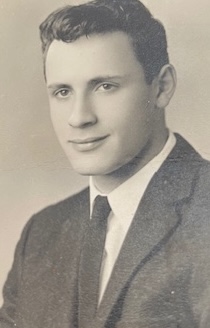
Tom graduated from Echo High School in May 1961, finishing tenth in a class of twenty-two seniors. In the fall, he enrolled in Minnesota State University at Mankato, where he studied business administration. He worked his way through college because that was the only way he could afford to attend. As graduation neared in 1965, some of Tom’s friends decided to take a trip to sign up for the Minnesota National Guard, which would protect them from the draft. For some reason that escapes him now, Tom declined to go. It was a decision he would soon regret.
Tom graduated from Minnesota State University at Mankato in May 1965 and received his draft notice soon thereafter. As directed, he reported to the Armed Forces Examination and Entrance Station in the Federal Building in downtown Minneapolis for his final physical and entrance processing. Although he had a college degree, he was drafted into the Army’s enlisted ranks, swearing an oath to support and defend the Constitution on October 20, 1965. He spent that night in a hotel with another draftee and they departed the next morning by train to begin their Army training.
On October 21, 1965, Tom and the other draftee arrived at Fort Leonard Wood, located about 140 miles southwest of St. Louis, Missouri. Tom soon realized he was older than all the other draftees because he had completed four years of college. The drill sergeants noticed too, making him the platoon’s recruit sergeant after his predecessor lost their confidence and the respect of the other recruits. This meant Tom had to march the platoon from event to event during the training day, perform various administrative functions, and make sure all the trainees in his platoon were where they needed to be when they needed to be there.
In addition to his leadership responsibilities, Tom had to participate in the recruit training just like everyone else. He excelled at the physical training because he’d kept himself in good shape after high school and college. He also enjoyed the rifle training with the M14, having been an avid hunter growing up. What he did not enjoy was “KP” (kitchen police), which he occasionally had to work in the wee hours of the morning. Already sleep deprived from the grueling training schedule, Tom found KP duty could sometimes test his limits. He discovered this when someone cut in the chow line and Tom put him in his place after losing his temper. All in all, though, Tom felt like the extra four years he had on the other draftees made it easier for him to handle the yelling and the pressure, so he made it through Basic Training with relative ease.
After graduating from Basic Training, Tom rolled directly into Advanced Individual Training (AIT), which was also at Fort Leonard Wood. There he earned his qualifications for his Military Occupational Specialty, or “MOS”, as a field wireman. This meant he would be responsible for installing, maintaining, and repairing communications wires and equipment wherever the Army assigned him. Tom found this ironic because he was afraid of heights and his new job required him to climb telephone poles. In fact, one of his tests required him to scale a telephone pole wearing cleats that he dug into the side of the pole as he climbed. When he reached the top, he had to strap himself onto the pole so he could safely work on the wires. Once strapped in, his instructors wanted him to catch and throw a basketball, which he refused to do, believing he’d already proved he could work on the poles. His instructors agreed and gave him a passing score on the test.
Near the end of AIT, a sergeant formed up the thirty-six members of Tom’s AIT training platoon and announced five members would be going to Vietnam and the rest would be going to Germany. He started calling out the names of the five going to Vietnam in alphabetical order, which gave Tom some comfort as he thought the sergeant would have five names before he made it to the s’s. He was wrong, and soon he heard the sergeant call his name. He was on his way to Vietnam.
Tom’s route to Vietnam took him from Fort Leonard Wood to McChord Air Force Base near Tacoma, Washington, where he stopped to await his follow-on flight. While there, he witnessed the caskets of soldiers killed in Vietnam being unloaded from an airplane. The sight was both scary and emotional, and brought home to Tom the distinct possibility he might not make it back to the United States alive. For the first time, he started to mentally prepare himself for the possibility.
In May 1966, Tom boarded a flight at McChord Air Force Base, which took him and other replacement soldiers to Saigon. His first observations were the heat waves rising off everything in the baking sun, the unique sweet smell in the air, and helicopters buzzing around from place to place. Since he was a replacement soldier filling in wherever the Army needed him, he didn’t know where he was going at first. As he waited for his assignment, he went to church. Afterwards, he learned he was being sent to Nha Trang, but that soon changed to the base camp at Cu Chi, located about twenty-five miles northwest of Saigon.
To get to the Cu Chi base camp, which was the headquarters for the 25th Infantry Division, Tom loaded on a helicopter together with his gear and prepared for the ride. The crew chief instructed him to sit on his helmet in case a stray bullet came their way. They took off, flying just over the treetops and landed safely in Cu Chi. Tom checked in with his unit and learned from the others who had been there for a while that the area had been quiet. He also learned they had work for him right away, so he dove right in, hanging wires on poles. As he did, a mortar round came in and hit the compound. He quickly got down from the pole and went into a bunker for shelter.
Once it was safe, Tom headed to a latrine capable of accommodating two people. He sat next to a big guy who recognized him as someone new. The veteran soldier asked Tom where he was from. After hearing Tom’s answer, he promised Tom his time in Vietnam would go by quickly and that he would be okay. Tom appreciated the reassurance and asked who the older soldier was. It turns out, he was Tom’s commanding officer. Tom never forgot his commanding officer’s kindness and appreciated him taking the time to calm the nerves of the unit’s newest arrival.
During Tom’s time at Cu Chi, he did more than just work with communications wires. He soon took over responsibility for the movie projector, showing movies for the soldiers to watch each week. This only lasted a couple of months, though, because he was replaced when the projector kept breaking down. His successor, and his predecessor for that matter, fared no better as the reason for the breakdowns was not operator error. Instead, it was just that the equipment was old and in need of replacement. Until that happened, projector operators would continue to be appointed and replaced.
As with the other junior enlisted soldiers at the base camp, Tom spent a lot of time filling sandbags. Once filled, the sandbags were stacked around the barracks and other buildings to absorb any shrapnel from enemy rocket or mortar attacks. Another responsibility Tom took very seriously involved standing duty and receiving target coordinates over the radio from units in the field asking for artillery support. He would carefully write down the coordinates so they could be relayed to an artillery unit, which would use them to fire at the target. The job required attention to detail because U.S. and allied units might be very close to the enemy units being targeted. A small mistake in recording the coordinates could result in significant friendly casualties.
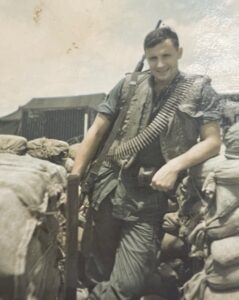
Tom also stood guard duty to ensure the Viet Cong did not penetrate the perimeter of the base. Normally, this meant manning a post on the base perimeter. Out in front of the post was a machine gun, which Tom could use to repel any would be attacker. Behind him was a bunker where he could take cover in the event of a rocket or mortar attack or get some rest when the other soldier with him manned the machine gun.
Not all the danger Tom faced came from the enemy. On one occasion, Tom was assisting a mortar crew. When the mortarman dropped the round into the tube, instead of launching at high speed toward the enemy, if flopped out of the tube and landed about three feet away. Everyone scrambled to clear the area, fearing it would detonate. Fortunately, the round turned out to be a dud.
On another occasion, the base camp wasn’t so lucky. Something set off a Claymore mine, killing a soldier. Shrapnel from the explosion pierced the top of the tent where Tom was at the time, but no one inside was injured. Tom went outside after the blast and saw the soldier who had been killed being carried away on a stretcher. The incident reminded Tom he could be killed at any moment even though he wasn’t outside the wire patrolling in the jungle.
About midway through Tom’s tour, he promoted to specialist (E-4) and transferred from Cu Chi to the Army airfield at An Khe, known as Camp Radcliff. The camp was located about 330 miles northeast of Saigon and close to the coast. Although off-duty soldiers were permitted to go into An Khe, Tom preferred to stay in the camp because he didn’t want to take any unnecessary chances. He preferred instead to enjoy a beer or two in his tent and play pinocle with the other soldiers who were counting down the days until their departure.
Tom had good reason to be concerned about straying away from the safety of the base. One day he witnessed U.S. aircraft dropping napalm in the jungle nearby, while enemy rocket propelled grenades hit the base. Although the engagement was over almost as soon as it started, it helped convince Tom of the wisdom of playing pinochle with his friends.
While at An Khe, Tom promoted to sergeant (E-5). He was upset, however, that one of the soldiers who worked for him did not promote, so he took matters into his own hands and promoted him. This did not sit well with Tom’s commanding officer, who not only removed the soldier’s unauthorized promotion, but also busted Tom back to specialist (E-4). It was a lesson Tom would not forget.
Tom eventually earned three days of R&R (rest and relaxation) in Vung Tau, a city located about 100 miles southeast of Saigon on the coast of the South China Sea. The great food and drink and the pristine beaches provided Tom with a welcome diversion from the war. After three days, he returned to his unit and his normal duties.
Toward the very end of Tom’s tour, he was transferred south to the vicinity of Black Virgin Mountain in Tay Ninh, located about fifty miles northwest of Saigon near Vietnam’s border with Cambodia. The mountain had a Marine communications facility located at the top, but the Viet Cong controlled the mountain’s slopes and the surrounding countryside. Tom’s unit was located with U.S. artillery components at the base camp.
With many Viet Cong operating around Tay Ninh, guarding the base camp perimeter at night was scary and it was easy to get spooked. Every sound coming from the jungle sent shivers down Tom’s spine because the noises sounded like Viet Cong guerrillas sneaking up to infiltrate the camp. Reports that the Viet Cong were preparing to attack the base camp put Tom and everyone else even more on edge. At one point, the warnings of an impending attack became so strong that Tom and the other soldiers were ordered to dig protective foxholes around the camp perimeter. The event stands out for Tom not only because of the fear of a possible Viet Cong attack, but also because he was repeatedly bitten by red ants as he dug his foxhole.
So he would be able to reload quickly when the attack came, Tom set out the magazines for his M16 in his foxhole. In the middle of the night, a soldier somewhere on the perimeter fired his weapon and Tom and the rest of the camp opened fire at the phantom foe lurking somewhere in the black jungle. After about three minutes, all was quiet. Tom was then instructed to go out into the jungle with two men from the communications team to set up a listening post. They ran a communications wire about twenty-five yards outside the camp and called in once they were all set up. Much to Tom’s relief, they were told to come back inside the camp perimeter. A few days later, Tom joined other soldiers on a patrol outside the wire. They set fire to a cache of rice they believed belonged to the Viet Cong before returning to the base camp.
About ten days prior to Tom’s scheduled departure from Vietnam, the artillery units at the camp helped repel an attack on their position by blasting the woods around them. The fight lasted fifteen minutes and Tom saw some of the casualties. Upset he was in such a precarious position days before he was scheduled to go home, Tom convinced his sergeant to allow him to join a convoy to Cu Chi that had just left the compound. The sergeant jumped into a jeep and told Tom and two others to hop in and they sped off to catch the convoy. Along the way they had to veer around an unexploded mortar round in the road and, once they caught up to the convoy, stop to change a flat tire. Although it was a nerve-racking ride, they made it to the base camp at Cu Chi safely. Now all Tom had to do was wait out his last few days for his flight back to the United States.
Waiting proved harder than it seemed, especially when some of Tom’s buddies suggested they grab a few drinks and head over to the nurses’ quarters to meet some nurses. The MP’s caught them, and Tom found himself standing at attention in front of his captain having to answer for his actions. He told Tom he wasn’t going to do anything formal because Tom was so close to going home. He did, however, direct Tom to go back to his tent and stay out of trouble until his departure.
Vietnam had one last send off for Tom before he departed in May 1967. The night before he left for Saigon, the base camp was hit by mortars. Tom jumped into a bunker and hoped he wouldn’t get hit just as he was getting ready to leave. He made it, and the next day, he caught his flight back to the United States.
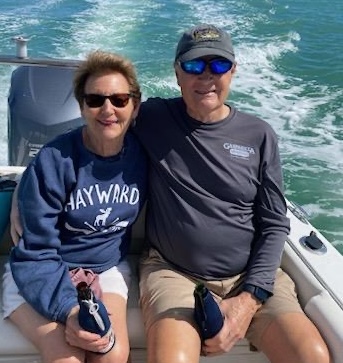
Once onboard the flight, the pilot welcomed everyone and instructed them to pull their shades down. He also told them there were plenty of sandwiches, beer, and sodas to enjoy on the way home. As the flight approached the coast of the United States, Tom opened his shade and saw the U.S. coastline. He still feels strong emotions when he thinks about that moment today.
Tom spent the last six months of his obligated service working for a Sergeant Major at Fort Benning, Georgia. The Sergeant Major tried to convince Tom to reenlist, but Tom wanted to get out. He did just that, receiving his honorable discharge on October 19, 1967. His first order of business was to return to Minnesota, where he went to work as an accountant for a few months with two computer companies. He also met a young woman, Cindy, at a party, and they were married. Afterwards, Tom started selling insurance, eventually launching his own company after gaining ten years of insurance experience at the corporate level.
Tom and Cindy are now semi-retired and love spending time with their family. They have one son, Christopher, who runs the family’s insurance business, daughter-in-law Tanya, and two grandchildren. Tom still stays plugged into the family business because he really enjoys the work, but he’s content to let his son have the reins.
Voices to Veterans is proud to salute Specialist 4 Thomas Steffl for his two years of wartime service in the Army. He answered our nation’s call as the Vietnam War escalated and served in harm’s way. He then returned to the United States, raised a family, and started a successful career, epitomizing the citizen soldier. We thank him for his service and wish him fair winds and following seas.
If you enjoyed Tom’s story, please sign up for the Voices to Veterans Spotlight monthly newsletter by clicking here. Once each month, you’ll receive a new written veteran’s story and a new podcast directly in your mailbox. Best of all, it’s free and you can unsubscribe at any time.

